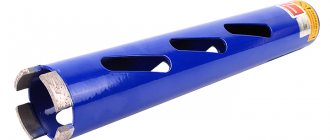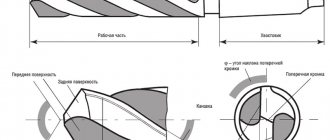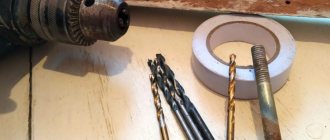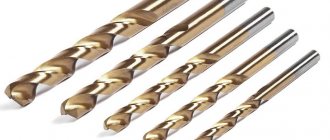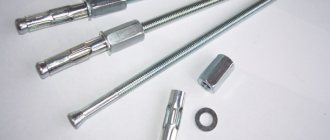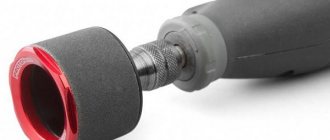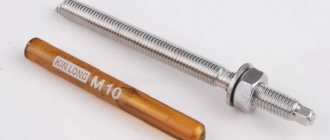From the author: hello, friends! To carry out repair and construction work, it is often necessary to drill into concrete and brick walls. Drills for metal surfaces are not suitable; they quickly begin to become dull and differ in the cutting part, quality and other features. Therefore, you need to know which drill bits for concrete are best, because there are quite a large number of their manufacturers.
Main types of concrete drills
A distinctive feature of a concrete drill from others is soldering. It is created from a strong alloy, due to which a hardness similar to diamond stones is achieved. Craftsmen call these types pobedit; these products differ in strength from other types that are created for metal or wood.
There are 2 main types by which concrete drills are classified:
- for a drill - consist of a shank for a nozzle, which is made in a cylindrical or multifaceted shape. The dimensions are small, the product is suitable for creating holes in many hard materials, for example, brick, foam block. It is recommended to use a high-power drill, which will allow you to drill into concrete,
- for a hammer drill - the drill is cylindrical in shape, has a shank, designations SDS PLUS or SDS MAX. The goods themselves are quite large and long, suitable for reinforced concrete structures.
If you need to create holes in a reinforced concrete structure using a simple drill, then it is not always possible to solve the problem with just a drill. You need to use a hammer drill, and for this tool, drills are divided into the following types:
- screw - used to create deep holes,
- spiral - suitable for large holes,
- flat - used for drilling passages of different sizes and depths.
For proper operation, you will need to not just insert the drill into the chuck, but snap it into place. To make this task easier, the products have a slight thickening at the very end. It should also be noted that the products are considered professional tools, since they can be used to create holes from 4 mm to 3 cm in diameter.
If you need a larger hole, then the crown type will come to the rescue. Such products make it possible to make a recess of 12 cm in diameter. The products are very durable and are produced in several versions:
- diamond - visually made in the form of a pipe or crown, mounted on a rod, the edges are coated with diamond, which ensures high strength,
- pobedit - similar to an attachment, the main difference from diamond is the absence of sputtering; it is replaced by special teeth made from pobedit.
It is recommended to use crown products for holes for sockets, switches or wiring, and other communications. To select a suitable concrete product for a drill, you will need to take into account not only the parameters of the element, but also the dimensions of the future hole. Based on this, the length of the drill is selected, which depends on the diameter:
- diameter 4 mm - length 5 cm,
- 5 mm - 10 cm,
- 6 mm - 15 cm,
- 8 mm - 25 cm,
- 10 mm - 54 cm,
- 12 mm or more - up to 100 cm.
It turns out that for large holes a long concrete drill is used. If you use thin instruments, there is a risk of damage due to increased load.
Design solution of the developers
The variety of drills on trading platforms is explained by their narrow functionality. Each product is designed to work with a specific type of material. It can be wood, ceramics or metal. Let's figure out what a drill bit for concrete looks like for a drill or hammer drill, and what the intraspecific differences between the tools are.
Comparative characteristics with other analogues
Drills, regardless of purpose, are structurally presented in approximately the same way. The shank is used to clamp the equipment in the chuck of the working tool. The central part of the rod has one or another thread with or without grooves to remove chips and small particles from the hole being formed. The main part of the product is a cutting tip with a cross-shaped head or similar to the letter T. It can also have different natural designs.
The table presents a comparative analysis of a drill for concrete against the background of analogues in terms of external characteristics.
| Tip | Angle between cutting edges (in degrees) | Tip color | |
| On wood | It has a pointed protrusion in the center. | 90-100 | Metal |
| On ceramics | Looks like a pointed blade, inserted into a rod. | About 60 | Steel |
| For metal | The shape is cone-shaped without protrusions. | 110-140 | Black |
| On concrete | Blunt with additional insert. | 130 | White metal |
Within their group, concrete drills are distinguished by the shape of the shank. So, a hammer drill has an automatic chuck. For it, you need to select equipment with a cylindrical seating element, in which there are internal grooves, and the shank is slightly expanded towards the end part. The former allow you to securely fix the rod so that it does not rotate. The second acts as a stopper and striker for performing work in the impact mode of the hammer drill. Conventionally, such gear is marked SDS (PLUS, MAX).
Drill shank for a hammer drill Source nborn.ru
There are two types of drill bits for concrete, let's look at which ones are better. Here the shank can be made round or hexagonal in cross section. Practice shows that in any case the cartridge reliably fixes the rod. Therefore, you can safely make a choice in favor of each type of equipment.
Inside the group of drills (drills for hammer drills) there is also a division according to the size and inclination of the cutting tip:
- Spiral . This is a classic execution of the central part. Here, debris is well removed from the formed hole. The problem being solved is drilling holes with great depth in thick structures (for example, in floor slabs).
- Screw . This equipment copes well with high-strength concrete. Their design allows them to perform work at high rotation speeds. Craftsmen also note that there is no need to sharpen the cutting part.
Auger drill Source my-tools.com.ua
See also: Catalog of companies that specialize in internal redevelopment
- Gentle . The main advantage of such a tool is its high working resource. But it has its drawbacks. Here you can only drill holes that are small in diameter, and the concrete chips have to be removed manually.
Another distinctive feature is the diameter of the equipment and the ratio of the latter to the length of the rod. In the first case, there is a difference between drill bits for a drill and drill bits for a hammer drill. The former are limited to a diameter of 12 mm, the latter – 30 mm. As for the length, it is impossible to make small holes of great depth, since the metal may burst from stress or overheating.
Work item
The tip of the drill and auger for working with artificial stone is equipped with a tip made of hard pobedite alloy. Its main constituent elements are cobalt (about 10%) and tungsten (almost 90%). Due to its high cost, the material is practically not used today and is replaced by cheaper alternatives. But on trading platforms the name has not been changed in order to avoid confusion among buyers.
Pobedite tip Source leroymerlin.gcdn.co
Features of drills
In order to choose the right drill for concrete structures, without making mistakes, you will need to know the features that distinguish them from products for metal and other materials.
The shape of the working area will be quite blunt; this area is made of a Pobedit plate. This type is suitable for concrete as woodworking products will include sharp tips. Due to this, at the beginning of the work, the wood is stuck inside, and only then a hole is made. The working area of a metal product is similar to a cone with no sharp points.
The color of concrete products is often metallic white. Products for wood will be strictly metal, and for metal, black colors are used.
Drilling Tips
There are a few simple rules to follow when drilling into concrete. Due to this, the work is performed more efficiently, and the service life of the product increases:
- When you first experience drilling concrete with a drill, you need to prepare several types of drills, you can even reserve them for metal. This is due to the fact that each type has its own purpose - for example, some are suitable for brick, while others are suitable for concrete and ceramics. When creating holes in the wall, there is a possibility that metal reinforcement will appear along the way, in which case the drill is changed and work continues,
- Some people specifically sharpen a concrete drill bit, so they can drill into metal during the job. This decision is wrong, since for the versatility of the product you will need to know many sharpening rules and have a lot of experience,
- It is forbidden to work without breaks; if the drill overheats, it may be damaged. It is recommended to drill for 15 seconds and then leave the drill to cool down. Do not use water or other mixtures for rapid cooling,
- Concrete always contains solid fractions in the form of stones, which can stop the drill during operation. It is easy to crush such inclusions with a chipper, and then continue to create a hole,
- if a hole needs to be made in a concrete wall, which is a load-bearing wall, or in ceilings, then it is better to use a hammer drill. Thanks to it, work is performed more efficiently and quickly,
- It is necessary to drill ceramics on walls or floors without the impact mode of the drill, otherwise the materials will be destroyed. Ceramic surfaces should only be worked with concrete drills,
- Cheap concrete drills are made from low-quality alloy, so they are not hard and need to be sharpened from time to time. To do this, you can use an angle grinder and a diamond disc,
- While drilling, it is not recommended to put pressure on the drill; this causes loss of balance, and drilling becomes more difficult. In addition, there is a possibility of the drill breaking, it simply bursts,
- To make holes for plastic dowels, it is recommended to make the depth a little larger. Dust and other dirt will not allow you to place the element correctly, a reserve is simply necessary,
- You need to start drilling concrete with low drill speeds so that the drill does not jump and the hole is smooth. After reaching a certain depth, the speed increases or the tool switches to impact mode,
- If the drill is used very often and for a long time, then you need to replace the chuck. Over the years, the fixation weakens, so the quality of work decreases, there is a risk of injury,
- When drilling, experts recommend soaking the drill in cold water, but not cooling it using this method. This rule protects the product from damage,
- To maintain cleanliness while working, it is recommended to put a plastic cup on the drill. This protects against flying concrete dust,
- Do not hold or hold the chuck with your hands while the drill is operating. You can only hold on to the body,
- When using gloves and protective clothing, it is important to use the correct size to avoid getting caught in the cartridge. Additionally, it is recommended to wear glasses to protect your eyes from dust.
When working according to the rules and using these tips, drilling concrete will be a simple and safe task, and the drills will last a long time.
Sharpening
When drilling concrete surfaces, sooner or later there is a need to sharpen the working part, even if it is made of diamond or coated with diamond. For the procedure you will need to use a sharpener or a special machine. In addition, at home you can use a regular universal machine or sharpen attachments with a grinder.
It is important to inspect the drill tip before doing any work. It should have 2 “shelves” that are the same length. Otherwise, damage will occur during drilling, and the holes themselves will be of poor quality. The whole sharpening process is not complicated, the main thing is to ensure the evenness of the shelves:
- for concrete and other hard materials, the alpha angle is 200–300,
- the cutting edges must not touch the grinding wheel, otherwise there is a risk of breakage,
- When sharpening, it is forbidden to bring the drills to heat; from time to time you need to pause and cool the material; the use of water is allowed. If the working part is hot, then it must be left to cool in the usual way, since contact with water risks cracking the drill.
Sharpening a drill for concrete is a complex process that requires certain skills, so without knowledge it is better to turn to the experts.
Drill design
The design of the drill is quite standard. It consists of standard components such as a shank, cutting elements and chip removal elements. Made from alloys of increased hardness, the tip resembles the letter T.
Such tips are used when working with hard materials (metals, concrete, marble). To avoid confusion, it is better to look at a photo of a concrete drill.
Some of the best concrete drills are Pobedit drills. Pobedit is a special alloy of tungsten and cobalt, but quite a long time ago this alloy ceased to be used due to its high cost and was replaced by cheaper and higher-quality analogues.
The pobedite drill is presented on the market in very large quantities, but the brand name of the drill itself is not indicated on the description, which means that you can select it yourself based on your experience or the knowledge of the seller.
If you see drills with strange Chinese symbols, it is better to avoid this purchase, since they will only last for a couple of minutes of work (at best).
There is one tradition, the essence of which is to wet the tip of the drill (or the entire drill bit) with water. Some argue that this procedure will preserve the drill and lead to better work without breakage. But as production researchers found out, cooling the drill does not affect its operation in any way.
Also, a Pobedit drill can be sharpened quite easily, but this must be done carefully - there is a risk of overheating the drill and breaking off part of it. This should be done when the drill becomes dull.
Review of manufacturers
Drills that are used for concrete are produced by both domestic and foreign companies. The cost largely depends on the country of origin. The high price of the product is justified, since all types of concrete products are characterized by a long service life and improved quality. It is very difficult to say exactly which is the best concrete drill bit for a drill. Among the leaders from foreign brands are:
- Makita - precision drills with unusual brazing. While working, it is easy to create smooth and clear holes of different sizes, but more often they are shallow,
- Bosch is the most popular company producing equipment and materials for repairs and construction. The drills have a four-spiral working surface. This ensures maximum performance and minimum friction. Often used for drilling concrete of any density and creating deep holes,
- Diager Twister is a company that is distinguished by its high reliability and high-quality product. Drills are used for both concrete, brick, and other stones. The assortment is very large, there are drills for drills, hammer drills and other tools,
- Metabo and Staver .
The companies described produce high-quality products, but they are expensive. Among domestic companies and manufacturers from the CIS and China, it is necessary to highlight:
- Bison are the most common drills from domestic manufacturers. The company offers a large assortment at an affordable price with good quality,
- Interskol,
- Anchor,
- Hurricane.
Chinese drills can be quite good and reliable, but they cost more than usual. It is worth understanding that high-quality goods cannot be cheap, since only the best raw materials and new technologies are used for their production. To make the right choice, it is recommended to watch the video:
Products with low cost may be made from a poor alloy, or made in violation of the technological process. There are many fakes that are almost no different from the original. Craftsmen claim that a fake is always darker in color, since some of the stages during casting are skipped or disrupted. To save money, it is better to buy drills in a set rather than individually.
Types and parameters of drills - distinctive features
When choosing a drill for concrete, builders ask how to distinguish its characteristics and make the right choice. Each product differs in size and is produced in a given diameter and length. One of the small drills for concrete work is 4-5 mm, it is no longer possible to drill a thinner hole of this diameter, its depth will be about 5 cm.
If you need to make a deeper hole, you need to take an element with a larger diameter, because types of drills are made in a size directly proportional to its length.
For example, with a diameter of 12 mm or more, the drill will be 1000 mm long, this will be enough to make a through hole in all walls except the bunker. The largest diameter is about 30 mm, it is not easy to work with, there is a heavy load on the hammer drill, and it takes a lot of time to cool down.
If it is necessary to make a larger hole, a core drill is used, which has a centering drill and a crown around it. Thanks to this, the process goes quite quickly, and the load on the hammer is small.
The core drill is coated with diamond coating or lining made of pobedit. A drill with a pobedit tip is set to the drilling and impact mode, with a diamond tip - to the drilling mode.
Drills from Pobedit
Pobedit as an alloy was developed in 1929, the main composition is cobalt and tungsten, where 10% cobalt and 90% tungsten. Effectively cope with brick, cinder block, concrete. The drill can be used to crush and cut concrete; it can withstand impact loads quite well, and no deformation of its cutting edges is observed. Steel products are subject to deformation and do not work as efficiently.
The technology for producing the alloy is low in cost; the alloy was developed for installation work that requires drilling of complex structures.
Application area:
- Drilling holes when laying electrical communications.
- A pobedite drill bit can be used to make holes for anchors and other fastenings.
- Channels when installing connecting elements in walls during the construction of building frames.
- Dismantling concrete structures, drilling large-diameter holes for laying ventilation and sewage systems.
- Installation work on fastening elements during the assembly and installation of furniture and fittings.
- Working with fragile materials such as ceramic tiles and glass.
- Drilling hard rocks from stone, hard alloys.
One of the advantages of the work is that there is no need to apply excessive force to the Pobedit drill.
Diameter selection
The diameter of the drill is selected taking into account the fact that when working with dense material, such as concrete, beating occurs during operation. As a result, the hole comes out slightly larger than planned. For this reason, the diameter should be taken slightly smaller than the planned hole itself. The length of the element indicates the greatest depth that the hole should be.
Most popular brands
The best concrete drill bits for drills from foreign manufacturers:
- Makita;
- Bosch;
- Metabo;
- stayer;
- FIT.
The products are considered to be of high quality, and therefore have a high cost, especially Bosch products, which have a four-spiral design.
Domestic manufacturers:
- Interskol;
- Bison;
- Anchor;
- Hurricane.
Drills have an average price category and, accordingly, a short service life. Products from a Chinese manufacturer can also be of good quality, but only if they belong to the appropriate price category. When constructing buildings in Moscow and other Russian cities, workers often use the listed product brands.



